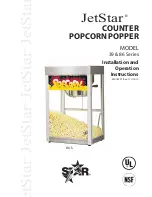
9
10
MODEL: NH43-5-R
MODEL: NH43-5-R
1. Select ripe produce that is in good condition.
2. Wash food thoroughly to remove dirt or chemicals. Make sure to remove any soft or
spoiled areas. Slice and pretreat if necessary.
3. Slices should be between 1/8”-1/4” for efficient drying.
4. Drying times will vary according to the size of the load, thickness of the slice, \
humidity of the air, and the moisture content of the food itself.
5. To test for dryness let the product cool, and then cut a piece open. There should be
no visible moisture inside.
6. Fruits tend to be leathery in dryness; vegetables tend to be brittle.
7. The natural juices in foods, especially in fruits, will vary.
8. Some fruit sugars tend to be stickier than others.
9. When loading trays, food should not overlap.
10. There is a threshold of approximately 6%-10% of moisture that may remain in foods
after dehydration without the risk of food spoiling.
11. Many dried foods will have a leathery consistency similar to licorice.
12. Blanching is advisable for vegetables to inactivate the natural enzymes that
are responsible for undesirable discoloration. It also makes the dehydration and
rehydration processes go faster. In some cases blanching is used to tear the skin of
fruits which allows moisture to escape.
13. It is necessary to rotate the trays every 2-4 hours. To do this, move the bottom trays
up and top ones down and turn to the right or left.
14. Trays toward the bottom of the dehydrator are exposed to the hottest and driest
air, causing them to dry more rapidly.
15. Turn each tray a quarter turn sideways to help ensure more even drying.
16. When correctly dried, most of your fruits and vegetables will be soft and pliable,
without any damp spots.
17. To remove seeds or pits from prunes, grapes, cherries, etc., dehydrate about
halfway - and then pop seeds out. This prevents juice from dripping out.
18. The Dehydrator has two adjustable lid vents and base vents in order to maintain
circulation while dehydrating. Do not operate with the lid of bottom vent blocked
or closed at any time. This will interfere with proper airflow.
19. Occasionally check to see if your food is dehydrated. The Food Dehydrator is
designed to rely on natural heat convection to remove moisture from the food.
20. Do not use any oils or sprays on the trays.
DRYING MEAT OR FISH HINTS & TIPS
IMPORTANT:
The USDA's current recommendation (as of 2017) for making jerky safely is
to pre-heat meat to 160°F and poultry to 165°F before the dehydrating process. This step
ensures that any bacteria present will be destroyed by wet heat. Because this product only
reaches 158°F, before dehydrating meat or poultry, make sure to heat up the food to the
recommended temperature as directed.
Suggestions for Safe Meat Dehydration include:
• You can boil the meat for 5 minutes prior to dehydrating. Once the internal temperature of
the meat (160°F) or poultry (165°F) has reached its respective recommended temperature,
the food is safe to dehydrate.
Tips & Tricks
Cleaning & Maintenance
FOR FIRST TIME USE
Wash the drying trays and top lid in hot water, clean with neutral detergent, rinse in potable
water and let them dry. Switch the appliance on without drying any food and let it operate
for a minimum of 4 hours. Switch the appliance off and let the parts of the food dehydrator
cool down and air out so that the possible after-production smell will be completely
removed.
CLEANING AND MAINTENANCE
Before cleaning, switch the appliance off and unplug it from the wall socket. Clean with a
soft, dry or damp cloth. For harder to remove foods or residues, use neutral detergent.
Do not use any abrasive cleaning agents, scourers, etc to clean the appliance.
Remove the plug from the wall socket if the appliance has not been used for a long time.
Before putting the appliance in storage, clean thoroughly, then cover with a plastic bag and
store in a dry place.
Keep appliance away from children!
• You can dehydrate the meat or poultry first and then afterward, place in your oven at a
minimum temperature of 165°F (74°C) for at least 30 minutes.
• Meat must be sliced very thinly to be dried. Partially freeze meat for up to 1 hour. Remove and
slice thinly across the grain. Place on the Drying Trays right away. Do not crowd or overlap the
meat slices.
• When done, test a piece of meat. It should crack when bent without snapping. Remove and cool
completely on racks. Store in sealed plastic bags for up to 2 weeks or freeze until use.
• Create a great low fat Teriyaki Chicken Jerky by thinly slicing chicken breasts and marinating
in Teriyaki sauce for 1 hour prior to drying. Arrange on Drying Trays right away right away and
dry at 145°F until crisp. When done, add crushed red pepper, chili powder or other spices to kick
up the flavor.
• Seafood fillets should also be thinly sliced. If needed, partially freeze the fish first, then thinly
slice with a sharp knife. Remove any bones, even small ones, for best results.
Drying times may vary product to product even if it is the same product. Drying
times are effected by room temperature, humidity, moisture content within the
product and preparation of the item. Natural juices within foods will vary. Some
fruit sugars tent to be stickier than others.
Thoroughly wash all food items to remove dirt, mold or chemicals before dehy-
drating!





























